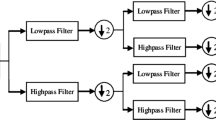Abstract
The subject of this paper is to show how the variogram of a spectral band ratio u = arctan(x/y) is controlled by the statistical parameters and spatial variation of the individual bands x and y, as well as the correlation coefficient ρ between the bands. Based on certain assumptions about the histograms and variograms of x and y, an approximate mathematical expression for the variogram of the band ratio is derived, which shows that the sill of the variogram of u depends on the ratio of the variance of x to the variance of y. As long as the correlation coefficient ρ increases, the sill decreases. The spatial variation of u for various distances h between pixels depends on the ranges of the variograms of bands x and y, as well as on the correlation coefficient between the bands. Experimentation with satellite images shows a good agreement between theoretically calculated and actual variograms of u, in qualitative terms and, in a considerable extent, in quantitative terms. The proposed methodology may be useful in assessing the efficiency of spectral bands and vegetation indices in environmental and geological remote sensing.









Similar content being viewed by others
References
Atkinson PM (2001) Geostatistical regularization in remote sensing. In: Atkinson NJ, Atkinson PM (eds) Modelling scale in geographic information science. Wiley, New York, pp 237–260
Bachmaier M, Backes M (2011) Variogram or semivariogram? Variance or semivariance? Allan variance or introducing a new term? Math Geosci 43:735–740. doi:10.1007/s11004-011-9348-3
Curran PJ (1988) The semivariogram in remote sensing: an introduction. Remote Sens Environ 24(3):493–507
Garrigues S, Allard D, Baret F (2007) Using first- and second –order variograms for characterizing landscape spatial structures from remote sensing imagery. IEEE Trans Geosci Remote Sens 45(6):1823–1834
Garrigues S, Allard D, Baret F, Morissette J (2008) Multivariate quantification of landscape spatial heterogeneity using variogram models. Remote Sens Environ 112(1):216–230
Garrigues S, Allard D, Baret F, Weiss M (2006) Quantifying spatial heterogeneity at the landscape scale using variogram models. Remote Sens Environ 103(1):81–96
Gringarten E, Deutsch CV (2001) Teacher’s aide. Variogram interpretation and modelling. Math Geol 33(4):507–534
Gupta RP (2003) Remote sensing geology, 2nd edn. Springer, Berlin
ILWIS 3.4. (2007) Open version. ITC, Netherlands
Jensen JR (1996) Introductory digital image processing. A remote sensing perspective, 2nd edn. Prentice Hall, New Jersey
Julesz B (1962) Visual pattern discrimination. IRE Trans Inf Theory 8(2):84–92
Lacaze B, Rambal S, Winkel T (1994) Identifying spatial patterns of Mediterranean landscapes from geostatistical analysis of remotely sensed data. Int J Remote Sens 15(12):2437–2450
Liang S (2004) Quantitative remote sensing of land surfaces. Wiley-Interscience, New York
Mikhail EM, Bethel JS, McGlone JC (2001) Introduction to modern photogrammetry. John Wiley & Sons Inc, New York
Myers DA (1989) To be or not to be…Stationary? That is the question. Math Geol 21(3):347–362
Schabenberger O, Gotway CA (2005) Statistical methods for spatial data analysis. Chapman & Hall/CRC, Boca Raton
Schowengerdt RA (1997) Remote sensing. Models and methods for image processing. Academic, New York
Skianis GA, Nikolakopoulos K (2010) The entropy of the image histogram as a measure of the performance of the NDVI vegetation index-a probabilistic approach using ALOS digital images. Hell J Geosci 45:249–255
Skianis GA, Nikolakopoulos KG (2009) A study of the performance of the Modified Simple Vegetation Index (MSVI), based on probability theory. In: 29th Earsel Symposium (Chania, Greece, IOS Press), 287–294. doi: 10.3233/978-1-60750-494-8-287
Skianis GA (2012) The problem of the spatial variation of a spectral band ratio: a first order approach based on probability theory. Earth Sci Inform 5(1):13–21
Skianis GA, Vaiopoulos D, Nikolakopoulos K (2007) A probabilistic approach to the problem of assessing the efficiency of the transformed vegetation index. Int J Sus Dev Plann 2(4):461–480
Skianis GA, Vaiopoulos DA, Nikolakopoulos KG (2009) Testing the performance of the MNDVI vegetation index. Proc SPIE 7472:747204. doi:10.1117/12.830262
Spiegel MR (1976) Mathematical handbook of formulas and tables. ESPI, Athens
Spiegel MR (1977) Probability and statistics. ESPI, Athens
Spiegel MR (1982) Advanced calculus. ESPI, Athens
Vaiopoulos DA, Skianis GA, Nikolakopoulos K (2004) The contribution of probability theory in assessing the efficiency of two frequently used vegetation indices. Int J Remote Sens 25(20):4219–4236
Woodcock CE, Strahler A, Jupp DLB (1988a) The use of variograms in remote sensing: a/scene models and simulated images. Remote Sens Environ 25(3):323–348
Woodcock CE, Strahler AH, Jupp DLB (1988b) The use of variograms in remote sensing: B/Real digital images. Remote Sens Environ 25(3):349–379
Acknowledgments
This paper is a part of a research project funded by ELKE, University of Athens (grant code number 10812).
Author information
Authors and Affiliations
Corresponding author
Additional information
Communicated by: H. A. Babaie
Rights and permissions
About this article
Cite this article
Skianis, G.A., Vaiopoulos, A.D. The variogram of a spectral band ratio with a considerable correlation between the bands. Earth Sci Inform 8, 161–169 (2015). https://doi.org/10.1007/s12145-014-0147-5
Received:
Accepted:
Published:
Issue Date:
DOI: https://doi.org/10.1007/s12145-014-0147-5




